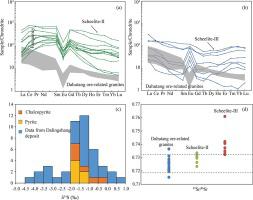当前位置:
X-MOL 学术
›
Ore Geol. Rev.
›
论文详情
Our official English website, www.x-mol.net, welcomes your feedback! (Note: you will need to create a separate account there.)
In situ trace elements and Sr isotopes in scheelite and S-Pb isotopes in sulfides from the Shiweidong W–Cu deposit, giant Dahutang ore field: Implications to the fluid evolution and ore genesis
Ore Geology Reviews ( IF 3.3 ) Pub Date : 2020-10-01 , DOI: 10.1016/j.oregeorev.2020.103696 Jingya Cao , Xiaoyong Yang , Dexian Zhang , Fabao Yan
Ore Geology Reviews ( IF 3.3 ) Pub Date : 2020-10-01 , DOI: 10.1016/j.oregeorev.2020.103696 Jingya Cao , Xiaoyong Yang , Dexian Zhang , Fabao Yan

|
Abstract The Shiweidong W–Cu polymetallic deposit, with resources of 300,000 t WO3 and 200,000 t Cu, is one of the major tungsten polymetallic deposits in the giant Dahutang ore field. This study conducted a series of in-situ analyses on scheelite and sulfides, aiming to provide some new insights into the sources, hydrothermal ore-forming processes, fluid evolution history and genesis of this deposit, which is of importance to understand the formation of the super-large Dahutang ore field. Quartz vein- and veinlet-disseminated-type tungsten ore bodies are mainly hosted in Neoproterozoic granodiorite and/or the Yanshanian porphyritic two-mica granites. Four stages of mineralization from early to late are identified in this deposit: 1) pegmatite stage; 2) silicate-oxide stage; 3) oxide-sulfide stage; and 4) sulfide stage. The δ34SV-CDT values of stage 3 chalcopyrite and pyrite are from −1.73‰ to −1.46‰ and from −1.66‰ to −0.31‰, respectively, indicating a magma-related hydrothermal origin. The 206Pb/204Pb, 2067Pb/204Pb and 208Pb/204Pb ratios of pyrite range from 18.169 to 18.295, 15.650 to 15.679, and 38.496 to 38.525, respectively, revealing a crust origin for the Pb. Trace element compositions of scheelite show that the both stage 2 scheelite (scheelite-II) and stage 3 scheelite (scheelite-III) have high contents of Nb and REEs. The scheelite-II has a narrow range of the Y/Ho ratios (16.2–31.0), obviously negative Eu anomalies (Eu/Eu* = 0.04–0.46) and relatively low 87Sr/86Sr ratios of 0.72640–0.73336, whereas scheelite-III shows variable Y/Ho ratios of 20.6–96.9, positive Eu anomalies (Eu/Eu* = 1.31–7.11) and relatively high 87Sr/86Sr ratios of 0.73496–0.76098. These data indicated that the Eu anomalies and Sr isotopic compositions of scheelite-II were inherited from magmatic-hydrothermal fluids, whereas those of scheelite-III were sourced from modified fluids due to intense fluid-rock interaction and input of meteoric fluids. Our data also reveal that the REEs of scheelite-II and scheelite-III are mainly controlled by the substitution mechanism of 3Ca2+ = □Ca + 2REE3+. The W-rich reduced fluids and intense fluid-rock interactions, which could provide enough W and Ca, are likely the key factors for the formation of scheelite in the Shiweidong tungsten deposit.
中文翻译:

大湖塘巨大矿田石卫东钨铜矿床白钨矿中的原位微量元素和Sr同位素以及硫化物中的S-Pb同位素:对流体演化和成矿的意义
摘要 石卫东钨铜多金属矿床,资源量30万吨WO3和20万吨Cu,是大湖塘大矿区主要的钨多金属矿床之一。本研究对白钨矿和硫化物进行了一系列原位分析,旨在对该矿床的来源、热液成矿过程、流体演化历史和成因提供一些新的认识,这对于理解白钨矿的形成具有重要意义。超大型大湖塘矿场。石英脉和细脉浸染型钨矿体主要赋存于新元古代花岗闪长岩和/或燕山期斑状二云母花岗岩中。该矿床由早到晚四个矿化阶段:1)伟晶岩阶段;2) 硅酸盐-氧化物阶段;3) 氧化硫阶段;4)硫化阶段。第三阶段黄铜矿和黄铁矿的δ34SV-CDT值分别为-1.73‰至-1.46‰和-1.66‰至-0.31‰,表明与岩浆相关的热液成因。黄铁矿的 206Pb/204Pb、2067Pb/204Pb 和 208Pb/204Pb 比值分别为 18.169 至 18.295、15.650 至 15.679 和 38.496 至 38.525,揭示了地壳的成因,白钨矿的微量元素组成表明,第 2 阶段白钨矿(白钨矿-II)和第 3 阶段白钨矿(白钨矿-III)均具有较高的 Nb 和 REE 含量。白钨矿-II 的 Y/Ho 比值范围很窄(16.2-31.0),明显的负 Eu 异常(Eu/Eu* = 0.04-0.46)和相对较低的 87Sr/86Sr 比值(0.72640-0.73336),而白钨矿-III显示可变 Y/Ho 比率为 20.6-96.9,正 Eu 异常(Eu/Eu* = 1.31-7.11)和相对较高的 87Sr/86Sr 比率为 0.73496-0.76098。这些数据表明白钨矿-II的Eu异常和Sr同位素组成来自岩浆-热液流体,而白钨矿-III的Eu异常和Sr同位素组成来源于强烈的流体-岩石相互作用和大气流体输入的改性流体。我们的数据还表明白钨矿-II 和白钨矿-III 的稀土元素主要受 3Ca2+ = □Ca + 2REE3+ 的取代机制控制。富含W的还原流体和强烈的流体-岩石相互作用,可以提供足够的W和Ca,可能是石卫东钨矿床白钨矿形成的关键因素。而白钨矿-III 的那些来自改性流体,这是由于强烈的流体-岩石相互作用和大气流体的输入。我们的数据还表明白钨矿-II 和白钨矿-III 的稀土元素主要受 3Ca2+ = □Ca + 2REE3+ 的取代机制控制。富含W的还原流体和强烈的流体-岩石相互作用,可以提供足够的W和Ca,可能是石卫东钨矿床白钨矿形成的关键因素。而白钨矿-III 的那些来自改性流体,这是由于强烈的流体-岩石相互作用和大气流体的输入。我们的数据还表明白钨矿-II 和白钨矿-III 的稀土元素主要受 3Ca2+ = □Ca + 2REE3+ 的取代机制控制。富含W的还原流体和强烈的流体-岩石相互作用,可以提供足够的W和Ca,可能是石卫东钨矿床白钨矿形成的关键因素。
更新日期:2020-10-01
中文翻译:

大湖塘巨大矿田石卫东钨铜矿床白钨矿中的原位微量元素和Sr同位素以及硫化物中的S-Pb同位素:对流体演化和成矿的意义
摘要 石卫东钨铜多金属矿床,资源量30万吨WO3和20万吨Cu,是大湖塘大矿区主要的钨多金属矿床之一。本研究对白钨矿和硫化物进行了一系列原位分析,旨在对该矿床的来源、热液成矿过程、流体演化历史和成因提供一些新的认识,这对于理解白钨矿的形成具有重要意义。超大型大湖塘矿场。石英脉和细脉浸染型钨矿体主要赋存于新元古代花岗闪长岩和/或燕山期斑状二云母花岗岩中。该矿床由早到晚四个矿化阶段:1)伟晶岩阶段;2) 硅酸盐-氧化物阶段;3) 氧化硫阶段;4)硫化阶段。第三阶段黄铜矿和黄铁矿的δ34SV-CDT值分别为-1.73‰至-1.46‰和-1.66‰至-0.31‰,表明与岩浆相关的热液成因。黄铁矿的 206Pb/204Pb、2067Pb/204Pb 和 208Pb/204Pb 比值分别为 18.169 至 18.295、15.650 至 15.679 和 38.496 至 38.525,揭示了地壳的成因,白钨矿的微量元素组成表明,第 2 阶段白钨矿(白钨矿-II)和第 3 阶段白钨矿(白钨矿-III)均具有较高的 Nb 和 REE 含量。白钨矿-II 的 Y/Ho 比值范围很窄(16.2-31.0),明显的负 Eu 异常(Eu/Eu* = 0.04-0.46)和相对较低的 87Sr/86Sr 比值(0.72640-0.73336),而白钨矿-III显示可变 Y/Ho 比率为 20.6-96.9,正 Eu 异常(Eu/Eu* = 1.31-7.11)和相对较高的 87Sr/86Sr 比率为 0.73496-0.76098。这些数据表明白钨矿-II的Eu异常和Sr同位素组成来自岩浆-热液流体,而白钨矿-III的Eu异常和Sr同位素组成来源于强烈的流体-岩石相互作用和大气流体输入的改性流体。我们的数据还表明白钨矿-II 和白钨矿-III 的稀土元素主要受 3Ca2+ = □Ca + 2REE3+ 的取代机制控制。富含W的还原流体和强烈的流体-岩石相互作用,可以提供足够的W和Ca,可能是石卫东钨矿床白钨矿形成的关键因素。而白钨矿-III 的那些来自改性流体,这是由于强烈的流体-岩石相互作用和大气流体的输入。我们的数据还表明白钨矿-II 和白钨矿-III 的稀土元素主要受 3Ca2+ = □Ca + 2REE3+ 的取代机制控制。富含W的还原流体和强烈的流体-岩石相互作用,可以提供足够的W和Ca,可能是石卫东钨矿床白钨矿形成的关键因素。而白钨矿-III 的那些来自改性流体,这是由于强烈的流体-岩石相互作用和大气流体的输入。我们的数据还表明白钨矿-II 和白钨矿-III 的稀土元素主要受 3Ca2+ = □Ca + 2REE3+ 的取代机制控制。富含W的还原流体和强烈的流体-岩石相互作用,可以提供足够的W和Ca,可能是石卫东钨矿床白钨矿形成的关键因素。


























 京公网安备 11010802027423号
京公网安备 11010802027423号